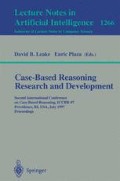Abstract
Because learning methods (i.e., knowledge repairs) can negatively interact, the arbitrary ordering of knowledge repairs can lead to worse system performance than no learning at all. Therefore, the problem of choosing appropriate learning methods given a performance failure is a significant problem for learning systems. Traditional case-based reasoners index learning or repair methods by specific failure characteristics so that once a failure is detected, a learning method can be brought to bear. Such tight coupling can be contrasted to a loose coupling in which the interaction between failure explanation and learning is mediated by the presence of learning goals generated by the learner. In an empirical study, the Meta-AQUA implementation performed significantly better under the guidance of learning goals (loose coupling) than under a condition in which learning goals were ablated (tight coupling). The conclusion is that unless repair interactions are known not to exist, a loose coupling is necessary for effective learning.
Preview
Unable to display preview. Download preview PDF.
References
Cox, M. T.. (1996). Introspective multistrategy learning: Constructing a learning strategy under reasoning failure. Doctoral dissertation, Tech. Rep. No. GIT-CC-96-06, Georgia Institute of Technology, College of Computing, Atlanta. (Available at URL ftp://ftp.cc.gatech.edu/pub/ai/ram/git-cc-96-06.html)
Cox, M. T. (1997). An explicit representation of reasoning failures. This volume.
Cox, M. T., & Ram, A. (1995). Interacting learning-goals: Treating learning as a planning task. In J.-P. Haton, M. Keane & M. Manago (Eds.), Advances in case-based reasoning: Second European Workshop, EWCBR-94 (pp. 60–74). Berlin: Springer-Verlag.
Hammond, K. J. (1989). Case-based planning: Viewing planning as a memory task. Vol. 1. of Perspectives in artificial intelligence. San Diego, CA: Academic Press.
Kass, A. (1986). Modifying explanations to understand stories. In Proceedings of Eighth Annual Conference of the Cognitive Science Society (pp. 691–696). Hillsdale, NJ: Lawrence Erlbaum Associates.
Kass, A. (1990). Developing creative hypotheses by adapting explanations. Doctoral dissertation, Northwestern University, The Institute for the Learning Sciences, Evanston, IL.
Owens, C. (1990a). Indexing and retrieving abstract planning knowledge. Doctoral dissertation, Yale University, Department of Computer Science, New Haven, CT.
Owens, C. (1990b). Representing abstract plan failures. In Proceedings of Twelfth Annual Conference of the Cognitive Science Society (pp. 277–284). Hillsdale, NJ: Lawrence Erlbaum Associates.
Ram, A. (1994). AQUA: Questions that drive the understanding process. In R. C. Schank, A. Kass, & C. K. Riesbeck (Eds.), Inside case-based explanation (pp. 207–261). Hillsdale, NJ: Lawrence Erlbaum Associates
Ram, A., & Cox, M. T. (1994). Introspective reasoning using meta-explanations for multistrategy learning. In R. S. Michalski & G. Tecuci (Eds.), Machine learning IV: A multistrategy approach (pp. 349–377). San Francisco: Morgan Kaufmann.
Ram, A., & Leake, D. (1995). Learning, goals, and learning goals. In A. Ram & D. Leake (Eds.), Goal-driven learning (pp. 1–37). Cambridge, MA: MIT Press/Bradford Books.
Redmond, M. A. (1992). Learning by observing and understanding expert problem solving (Tech. Rep. No. GIT-CC-92/43). Doctoral dissertation, Georgia Institute of Technology, College of Computing, Atlanta.
Schank, R. C., Kass, A., & Riesbeck, C. K. (1994). Inside case-based explanation. Hillsdale, NJ: Lawrence Erlbaum Associates.
Sussman, G. J. (1975). A computer model of skill acquisition. New York: American Elsevier.
Author information
Authors and Affiliations
Editor information
Rights and permissions
Copyright information
© 1997 Springer-Verlag Berlin Heidelberg
About this paper
Cite this paper
Cox, M.T. (1997). Loose coupling of failure explanation and repair: Using learning goals to sequence learning methods. In: Leake, D.B., Plaza, E. (eds) Case-Based Reasoning Research and Development. ICCBR 1997. Lecture Notes in Computer Science, vol 1266. Springer, Berlin, Heidelberg. https://doi.org/10.1007/3-540-63233-6_512
Download citation
DOI: https://doi.org/10.1007/3-540-63233-6_512
Published:
Publisher Name: Springer, Berlin, Heidelberg
Print ISBN: 978-3-540-63233-7
Online ISBN: 978-3-540-69238-6
eBook Packages: Springer Book Archive

